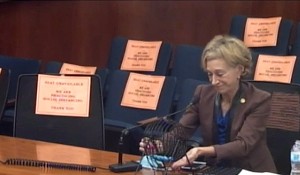The first five Santa Barbara County residents who will serve on a citizens’ redistricting commission were randomly chosen at a Board of Supervisors meeting on Oct. 13, but hanging over the process were unanswered questions about how applicants in the drawing pool were initially chosen and concerns about lacking representation.

Laura Katz, William McClintock, Norman Bradley, Cary Gray, and Glenn Morris are the first residents named to serve on the Citizens’ Independent Redistricting Commission, a group of 11 responsible for drawing the lines that will define the county’s five supervisorial districts for the next 10 years. The first five—one person from each district—were chosen randomly from a pool of a little more than 40 applicants and are now tasked with interviewing other candidates and filling the commission’s six remaining seats.
But the county initially received nearly 200 applications for the commission, and at the Oct. 13 meeting, community members and supervisors alike questioned the process county Registrar of Voters Joseph Holland used to whittle it down to what was supposed to be the 45 most qualified candidates. Instead, critics say Holland landed on a group that does not adequately represent the people of Santa Barbara County.
“We have, for example, only 13 percent Latino in this pool, whereas we have 46 percent in our population,” 3rd District Supervisor Joan Hartmann said at the meeting. “We have only 14 percent under the age of 40, when they’re 57 percent of our population. We have it skewed toward males: 65 percent when there’s 50 percent female in our population. So in other words you’ve created a skewed pool that is old, white, and male.”
Federal and state laws require district boundaries to be examined and adjusted every 10 years to ensure members of the public are equally represented, according to a county staff report. Historically, the county has redrawn supervisorial district maps through a public process facilitated by staff and consultants and ultimately approved by the Board of Supervisors.
But in 2018, Santa Barbara County voters changed the redistricting system with the approval of Measure G, which enabled the creation of the Citizens’ Independent Redistricting Commission, a group of 11 Santa Barbara County residents who will use data collected during the 2020 U.S. Census to adjust the boundaries of the county’s supervisorial districts. It’s an attempt to create districts that will better represent the county’s current population independently from elected and county officials.
As outlined in the ordinance, elections official Holland looked through all of the applications and chose the 45 “most qualified” based on applicants’ experience demonstrating analytical skills relevant to redistricting; the ability to be impartial; and an appreciation for the diverse demographics and geography of Santa Barbara County. Holland said when considering potential candidates, he looked to the criteria outlined in the ordinance.
“It does not request of me to take into account gender, age, or ethnicity,” Holland said at the meeting. “So I selected the most qualified of the applicants. I’ve reviewed thousands of applications throughout my career. And it’s always the case that applicants that don’t get accepted think they should have got accepted.”
That information didn’t seem to satisfy Hartmann, who then interjected to ask exactly what criteria Holland used to choose the final pool of 45 applicants.
“With all due respect,” he answered, “I’m not going to go into the criteria. The ordinance does not call for me to do that.”
Several community members also called in to complain about the lack of representation for Latinos, women, and young people in the pool, but others pointed out that those who applied are likely community members who are already deep into their careers and without young children to care for.
Still, it will be up to the first five commissioners to ensure the Citizens’ Independent Redistricting Commission is representative of all the county’s demographics.
“It will be very difficult for the people that are selected by this random process to fix the errors that are created by this initial pool,” 2nd District Supervisor Gregg Hart said. “And I think there will be tremendous concern from the residents of the county if this goes sideways at this stage.”








